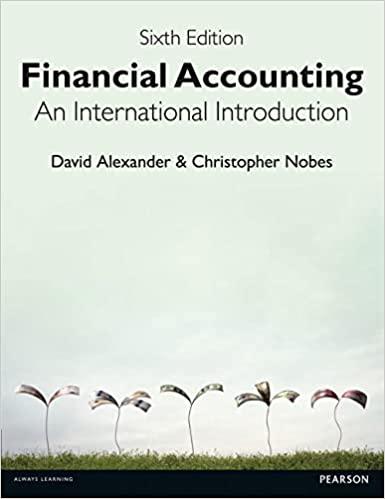Question
Private Company Case Nicole Jones is the CEO of a large manufacturing firm with operations worldwide. The firm is considering the purchase of a private
Private Company Case
| Nicole Jones is the CEO of a large manufacturing firm with operations worldwide. The firm is considering the purchase of a private entity, Vibrant Manufacturers Inc. that has recently been put up for sale by its owners. Jones has asked the financial department at his firm to value VMI and evaluate its purchase in light of their companys goals. Bob Wilshire, an expert in corporate venturing feasibility analysis, is responsible for the evaluation. VMI targets a niche market where it has just begun producing and distributing its product. Since the firms product is unique, Wilshire believes that it has the potential to operate as a large successful firm sometime in the future. However, the entry of new competitors and changes in the industrys structure may erode value and cause profit margins to diminish. Dynamic Manufacturers (DM) is another private firm that Wilshire is evaluating for purchase. Tommy Klines is the sole owner of the firm, and has put it up for sale after a few years of operations. While analyzing the firms financial statements, Wilshire found that Klines compensation for the current year was $2,500,000, whereas based on his own research Wilshire knows that the CEO of a company like DM is paid approximately $1,050,000. In addition, the firm owns some land close to Chicago, and some commercial property. These are not currently being used for the core business of the firm. The current financial statements include $500,000 of operating expenses, $300,000 of depreciation and $450,000 of operating income related to these assets on the income statement. The tax rate is 40%. In addition, Wilshire noted that Klines and a few other employees have travelled a lot over the past year. The travelling expenses total $100,000, which have been included as part of the SG&A expenses. Wilshire is planning to use the FCFF approach to estimate the value/share of Dynamic Manufacturers. Exhibit 1 shows some calculations that Wilshire has carried out to estimate the companys operating income after taxes. Exhibit 1 Dynamic Manufacturers Operating Income after Taxes As of Dec. 31 2019 As Reported
Based on available information, Wilshire has made the following assumptions for his valuation:
To ensure that Wilshire has made appropriate assumptions regarding the firm and has made proper adjustments to accounting information, Jones asks Norman Ash, Wilshires colleague, to value the firm using his own estimates. Ash plans to use the FCFE model to value the equity interest in the firm. To determine the appropriate rate of return for his calculation, Ash gathers the following information:
Wilshire has come up with the same information as above to determine a discount rate for his own valuation model. He gathered some additional information about the companys capital structure. The firm currently has 7% debt in its structure whereas according to various sources of financing, a 15% debt to capital ratio is considered optimal. The cost of debt is 9.45% and the tax rate is 37%. After performing the necessary calculations, Wilshire and Ash approached Jones to display their results. During a discussion with them, Jones made the following comments: Statement 1: Non-operating assets are assets that are not necessary to the ongoing operations of a business. Since they are not required for the core activities of a firm, when valuing an enterprise, only operating assets should be included. Statement 2: For companies with highly leveraged financial conditions and significant volatility in future financial performance, the valuation of equity as the residual obtained by subtracting the value of debt from the value of the firm is appropriate. |
Question
| Which approach to private company valuation would be most appropriate to value Vibrant Manufacturers Inc.? |
-
A.
The income approach. -
B.
The asset-based approach. -
C.
The market approach.
Question
| If Wilshire makes the necessary adjustments to the reported financial statements of Dynamic Manufacturers, the operating income after taxes will most likely: |
-
A.
increase by $780,000. -
B.
increase by $1,900,000. -
C.
increase by $1,140,000.
Question
| The forecasted FCFF for the next year of Dynamic Manufacturers is closest to: |
-
A.
$15,780,165. -
B.
$20,260,250. -
C.
$17,555,290.
Question
| The required rate of return on equity of DM based on the CAPM and expanded CAPM methods are closest to: |
-
A.
9.905% and 12.92% respectively. -
B.
10.57% and 15.57% respectively. -
C.
9.905% and 14.07% respectively.
Question
| If Wilshire decides to use the optimal capital structure and the build-up method for his discount rate calculation, the discount rate will be closest to: |
-
A.
13.15%. -
B.
14.42% -
C.
14.13%.
Question
| Jones is least accurate with respect to: |
-
A.
statement 1 only. -
B.
both statements 1 and 2. -
C.
statement 2 only.
Step by Step Solution
There are 3 Steps involved in it
Step: 1

Get Instant Access to Expert-Tailored Solutions
See step-by-step solutions with expert insights and AI powered tools for academic success
Step: 2

Step: 3

Ace Your Homework with AI
Get the answers you need in no time with our AI-driven, step-by-step assistance
Get Started


